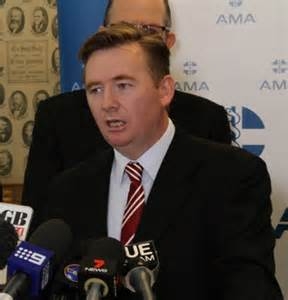
The health measures in the federal budget are almost universally opposed by the people who provide health services in Australia. The Australian Medical Association is at the forefront of this opposition.
The message is clear: the measures add up to bad health policy. The health of Australians is too important for healthcare to be an ideological toy.
While the AMA strongly represents the interests of doctors, we will always put the interests of our patients first. This is our professional obligation. It is why we oppose the budget measures. They will hurt our patients, especially the sickest and most vulnerable.
The AMA is supportive of some co-payments, but not the one proposed by the government.
The co-payment applies to general practice, pathology, and diagnostic imaging. But there are also two other troubling elements. The first is a $5 reduction in the patient Medicare rebate. The second is the loss of the bulk billing incentives (higher Medicare rebates to patients to encourage bulk billing) for diagnostic imaging and pathology. Unlike in general practice, these bulk billing incentives apply to all patients, not just concession holders.
In around 50 per cent of cases, pathologists never see or have contact with the patient. For outpatients, the specimen may be sent to the lab by the doctor. This makes the co-payment logistically impossible and costly to collect. This is a real problem, especially for small pathology practices, many of which are in rural areas.
In diagnostic imaging, the issues are even more significant. The loss of the 10 per cent bulk billing incentive, as well as the $5 rebate cut, means that radiologists face much greater losses. The patient will have to pay the whole amount for the test and claim the rebate afterwards. Diagnostic imaging practices that providing excellent services in disadvantaged areas will become unviable.
Anyone working in health understands the basic premise that prevention is not only better than the cure, but it also makes economic sense. Diagnosing and managing chronic disease properly in general practice keeps patients out of more expensive hospital care. People with chronic diseases are very much affected by the co-payment. This proposal poses a financial barrier for vaccinations and other preventative healthcare measures and chronic disease management.
The recent COAG Reform Council report showed that, among the more disadvantaged in society, 12 per cent of people defer or do not see their GP due to cost. It will significantly increase with a co-payment.
It is already difficult to secure services of GPs for aged care. It is impractical to collect co-payments in this setting, particularly from patients with dementia. It is only likely to drive GPs out of this area. If patients in aged facilities get sick, or can’t see a GP, they end up in an emergency department. It’s an expensive problem now but would get worse if the co-payment goes ahead.
Indigenous people are three times more likely to die from a potentially avoidable cause. Recent evidence indicates that 12.2 per cent of indigenous Australians do not access a GP because of cost in the current system. A co-payment will hamper our collective efforts to “close the gap” through indigenous healthcare.
The cumulative effects of the $7 co-payment can be significant even for a routine diagnosis.
Take the example of a young woman with a breast lump who needs a biopsy for diagnosis. As the impacts of the co-payments for GP, radiology, and pathology add up, the out-of-pocket costs rise to at least $63 over nine visits. Early diagnosis is essential. For some patients, these costs will deter them from accessing care and completing investigations. The effects of delayed diagnosis are expensive and often tragic.
What about the common scenario of the patient on warfarin? Not all of these patients will be under the cap of 10 co-payments for concession patients. There is usually a large number of visits, every few days at first, for International Normalised Ratio (INR) testing to determine whether the blood is too thin or thin enough. That will mean hundreds of dollars in co-payments.
Another reason for the AMA’s response to this proposal is the lack of evidence. Modern medicine is evidence-based. We are trained not to accept blind assertions or opinion, or indeed ideology, in determining the best treatment without the supporting evidence.
For months, Australians were pre-medicated for the budget on the narrative that Australia has a budget emergency, with the finger of blame pointed at an out-of-control health budget.
The health budget is not out of control. As a proportion of GDP, Australia’s healthcare spending has remained constant. In 2011 it was 8.93 per cent compared to the OECD average of 9.3 per cent. The proportion of this contributed by the federal government expenditure remains constant at around 41 per cent.
As a proportion of federal government expenditure, health expenditure has actually fallen – from 18.1 per cent in 2006-07 to 16.1 per cent in 2012-13.
The co-payment is unfair and unnecessary. Ideology has pushed this proposal too far. It is poor health policy. The Prime Minister should step in and scrap this policy. If not, it deserves to fail in the Senate.
Associate professor Brian Owler is president of the Australian Medical Association
Source: Sydney Morning Herald
